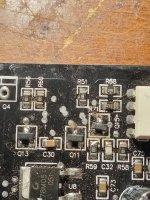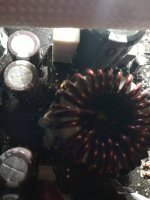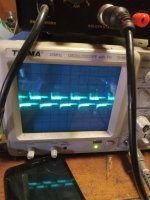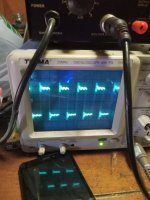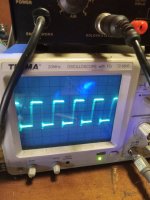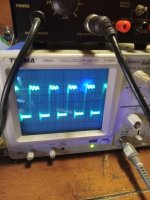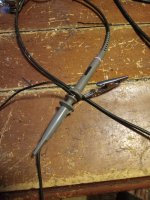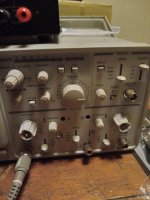Again:
Does that mean you have signal on the output filter inductor?
They are in correctly according to the photos of a 2000. I don't have good photos of a 3000.
Does that mean you have signal on the output filter inductor?
They are in correctly according to the photos of a 2000. I don't have good photos of a 3000.
Is what I posted that last pic of the output inductor? And by signal you mean the pwm looking drive? If so no.
I switched out the 2ts and 2xs and now there is a drive but it's still not right. I think I have another batch of 2ts and 2xs gonna try some of those. And d4 a zener diode was bad on the other side drive is fine there now! Thanks!!! It's coming along!
These amps typically have no bleeder resistors to drain the rail voltage so you need to drain the rail caps before you solder anything on the board. You can temporarily install a couple of bleeder resistors to drain the rails if you can't remember to drain the rail caps.
You need to use the scope in differential mode when checking the drive signals.
How are you checking the drive signals with a single probe? Are you grounding the probe to the source leg of the FET?
How are you checking the drive signals with a single probe? Are you grounding the probe to the source leg of the FET?
I was clipped onto the ground into the amp. Even without that it shows drive. I don't know how to use the scope at all. I'm just getting used to the multimeter. I'm below novice with all this
Is this with DC coupling?
You can find probes on ebay for about $5 each. Buy either 2 or 4 and when they arrive, get the scope working as described below.
A differential input uses two inputs to produce a single waveform. The simplest way to get a differential input is to use a differential probe. A differential probe has two signal leads and a mixer amplifier built into it. It feeds the scope a normal signal (a composite of the two signals input into the differential probe). The problem with differential probes is that they're expensive.
The alternative is to use two scope probes and and both inputs of your oscilloscope. This is how you have to set up your scope:
Two probes
Both scope inputs used
Input set to add
Both channels set to DC coupling
Both channels set to 'cal'.
Both vertical amps set to the same voltage
Ch2 input set to invert
Bandwidth limited (works best for most measurements in car amps)
Trace aligned to the reference line on the scope's display
Ground leads for both probes connected together (not always necessary)
After setting up the scope, you need to confirm that it's working as it should. With the vertical amp set to 5v/div, touching the probe that's connected to Ch1 to the positive terminal of your 12v power supply should make the trace deflect about 2.5 divisions up from the reference (like it always does, seen below). Doing the same with the probe connected to Ch2 should make the trace deflect down about 2.5 divisions. Touching both probes to the positive terminal of the 12v power supply should cause no deflection. If it does, something isn't right.
I know that this may not be as simple as the isolated scope but if you take the time to learn it one time (even if it takes an hour or more of your time), you have that knowledge and this tool to use for the rest of the time you need to use a scope. Using the analog scope will give you much larger and cleaner waveforms.
You can find probes on ebay for about $5 each. Buy either 2 or 4 and when they arrive, get the scope working as described below.
A differential input uses two inputs to produce a single waveform. The simplest way to get a differential input is to use a differential probe. A differential probe has two signal leads and a mixer amplifier built into it. It feeds the scope a normal signal (a composite of the two signals input into the differential probe). The problem with differential probes is that they're expensive.
The alternative is to use two scope probes and and both inputs of your oscilloscope. This is how you have to set up your scope:
Two probes
Both scope inputs used
Input set to add
Both channels set to DC coupling
Both channels set to 'cal'.
Both vertical amps set to the same voltage
Ch2 input set to invert
Bandwidth limited (works best for most measurements in car amps)
Trace aligned to the reference line on the scope's display
Ground leads for both probes connected together (not always necessary)
After setting up the scope, you need to confirm that it's working as it should. With the vertical amp set to 5v/div, touching the probe that's connected to Ch1 to the positive terminal of your 12v power supply should make the trace deflect about 2.5 divisions up from the reference (like it always does, seen below). Doing the same with the probe connected to Ch2 should make the trace deflect down about 2.5 divisions. Touching both probes to the positive terminal of the 12v power supply should cause no deflection. If it does, something isn't right.
I know that this may not be as simple as the isolated scope but if you take the time to learn it one time (even if it takes an hour or more of your time), you have that knowledge and this tool to use for the rest of the time you need to use a scope. Using the analog scope will give you much larger and cleaner waveforms.
- Home
- General Interest
- Car Audio
- Audiopipe 30001D
